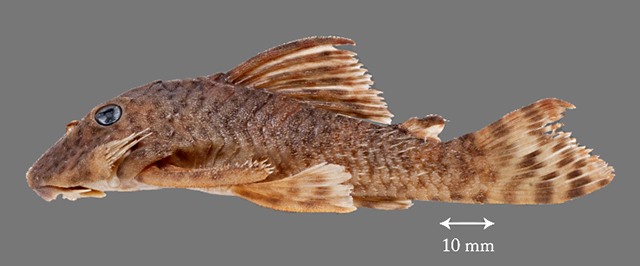| Loricariidae (Armored catfishes), subfamily: Hypostominae |
| 7.65 cm SL (male/unsexed) |
|
demersal; freshwater |
| South America: upper Maroni River basin in French Guiana and Suriname. |
|
Dorsal spines (total): 2-2; Dorsal soft rays (total): 7-7; Anal soft rays: 5-5. This species can be diagnosed from all other congeners by a unique color pattern of adults, and from Guianese species by its specific barcode sequence (JF747005). Color pattern consists of numerous blackish-brown spots of irregular size and shape, distributed on head and on entire body except naked ventral areas, resulting in a mottled aspect of dorsum, while spots are aligned to form transverse bands on fins, at least on caudal fin. Juvenile specimens present large transversal blackish bands, or dorsal saddles, on the body that are similar to those characteristic of several Peckoltia including the type species Peckoltia vittata. Brown spots on posterior part of the body are also present in Peckoltia oligospila, Peckoltia sabaji, Peckoltia capitulata and Peckoltia simulata, but in these species spots are rounded, comparatively larger and regularly spaced, and they usually do not form bands on fins. It is further distinguished from these species by having a deeper body (22.5-25.7% SL, mean 23.8, vs. less than 23.4 at occiput; 12.4-13.8% SL, mean 13.1, vs. less than 11.7 at caudal peduncle) and a wider body (33.8-37.1% SL, mean 35.2, vs. less than 32.7 at cleithrum). Differs from Peckoltia bachi that is also mottled, by having the eye high on the head (vs. low) and a much narrower interorbital (29.8-34.4% HL, mean 32.6, vs. 57.9-59.9, mean 58.8) (Ref. 90183). |
| In rapids, it occurs mostly in sunny and shallow clear water, swiftly flowing currents, with medium- sized rocks substrate (Ref. 90183). |
|
Vulnerable (VU); Date assessed: 14 January 2021 (B1ab(iii)) Ref. (130435)
|
| harmless |
Source and more info: www.fishbase.org. For personal, classroom, and other internal use only. Not for publication.

